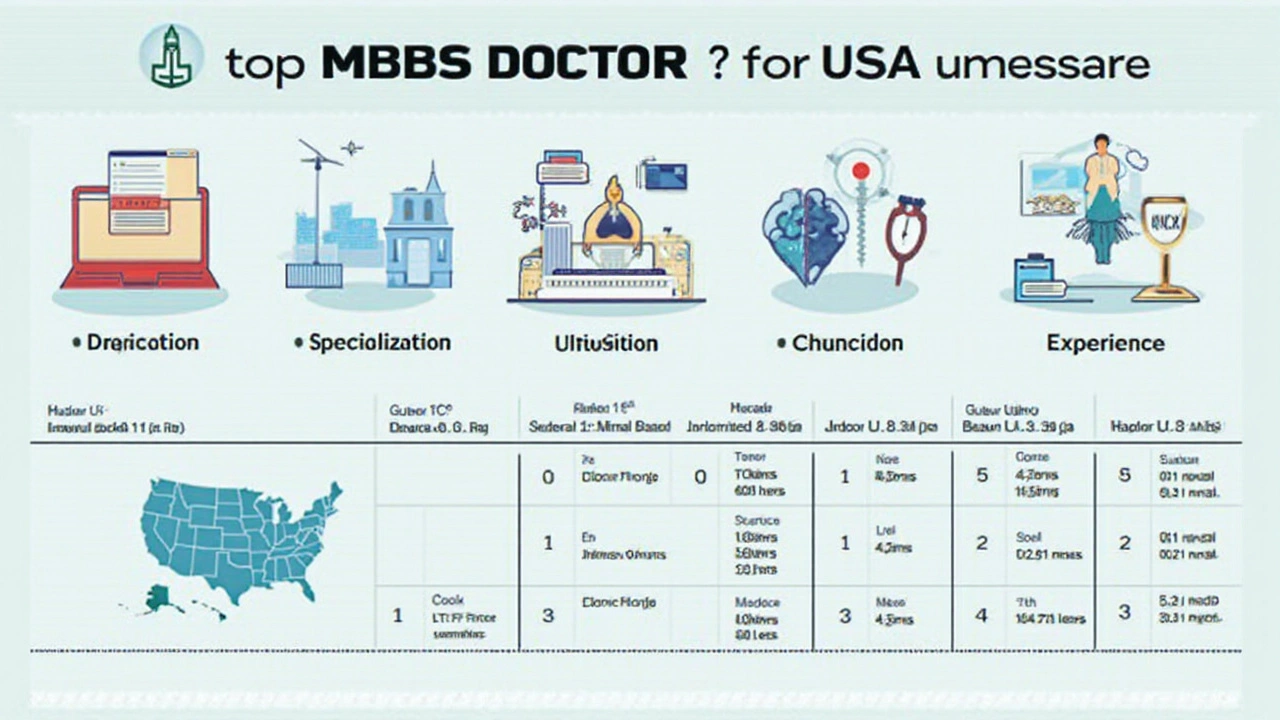So, you're thinking about making the jump to the USA as an MBBS doctor? First things first—what you can earn might surprise you. The paychecks in America aren't just influenced by your medical degree but also by where you decide to plant your roots and what kind of doctor you become.
Let's break it down. Fresh out of your residency, you might not hit six figures right away. The starting salary for a general practitioner usually sits around $60,000 to $120,000 per year. But don't sweat it, because with a bit of experience, you could double that, or more!
The area you choose to live in is a game-changer too. New York and California? Sure, they've got the glam, but they also have a high cost of living. Texas and Florida, on the other hand, might offer just as much sun but significantly better bang for your buck with salaries often higher than the national average.
- Understanding the Basics
- Factors Influencing Salaries
- Regional Salary Differences
- Comparing with Other Countries
- Financial Tips for Future Planning
Understanding the Basics
If you're dreaming of working as an MBBS doctor in the USA, knowing how things roll is crucial. To start, MBBS here isn't exactly what it sounds like in countries like India or Australia. The equivalent in the USA is getting your MD (Doctor of Medicine) degree after completing pre-medical studies, medical school, and a residency program.
Now, let’s talk cash. You might expect to earn big bucks right from the get-go, but hang on a sec. Initially, the earnings for doctors aren’t sky-high. Right out of residency, expect a paycheck in the range of $60,000 to $120,000 annually, depending on your specialty. Not mind-blowing, but it’s the starting line.
It’s often during or right after residency when doctors begin to see a hefty increase in their salaries. According to recent surveys, experienced physicians can make anywhere from $150,000 to well over $300,000 a year. Specialists like cardiologists and orthopedic surgeons often snag the higher end of the spectrum.
It's essential to take note of the educational and exam requirements too. To practice in the USA, passing the USMLE (United States Medical Licensing Examination) is a must. It's a comprehensive test with three steps, covering topics from basic biological sciences to clinical practice skills.
Here's a simple breakdown of the journey:
- Complete your pre-medical studies.
- Pass the MCAT and secure admission into a medical school.
- Finish medical school to earn an MD.
- Complete a 3-7 year residency program in your chosen specialty.
- Pass the USMLE to get licensed.
- Seek board certification for better job prospects (optional but encouraged).
Factors Influencing Salaries
Alright, let's get into what's really driving those paychecks. When it comes to the salary of an MBBS doctor in the USA, several things can tip the scales. First off, your specialty is a biggie. Surgeons and anesthesiologists often see much heftier paychecks than general practitioners or pediatricians. That's primarily because of the extensive training and skill set needed in these specialized areas.
Experience also plays a big role. The more years you put in, the more you stand to earn. Many doctors see a significant bump in their income after moving past the five or ten-year mark. Think of it like a loyalty bonus for sticking with the grind.
On top of that, where you work can massively impact your income. Generally, urban centers like New York or San Francisco may offer higher salaries but balance this with steeper living costs. Meanwhile, some states, like Texas or Tennessee, pay well and have a lower cost of living, making your take-home pay stretch further.
Then there's the competition factor. If you're in a region saturated with medical professionals, that might put pressure on salaries. However, underserved areas might offer you financial incentives, like signing bonuses or loan repayments, to attract talent.
Lastly, the type of healthcare facility is worth considering. Working in a private practice, hospital, or even starting your own clinic can influence not only how much you earn but also how you manage your finances and lifestyle.
Keep these elements in mind as they can vastly change what those numbers look like at the end of the month on your payslip!

Regional Salary Differences
Alright, let’s get into where you might want to hang your stethoscope based on salary potential. If you're aiming to maximize your MBBS salary in the USA, choosing the right location can make a huge difference.
Let's start with the high rollers: states like California and New York offer impressive pay, but be ready to fork out a large chunk on living expenses. Reports show that doctors in California can earn upwards of $150,000 annually, but the high cost of living in cities like Los Angeles and San Francisco might take a big bite out of that.
Texas, on the other hand, is a bit of a unicorn. Here, doctors often enjoy higher-than-average salaries, sometimes hitting $200,000 per year, combined with a much lower cost of living. Sounds like a win-win, right?
"Choosing a state with no income tax, like Texas, can significantly boost your take-home pay," says Dr. Sarah Lane, a healthcare economist based in Dallas.
Doctor income in rural areas can also be notably higher due to demand. States like Montana and Idaho may offer incentives such as loan repayment or bonuses to attract doctors, resulting in appealing compensation packages.
To give you a clearer picture, here’s a snapshot of average annual incomes in various regions:
| State | Average Salary |
|---|---|
| California | $160,000 |
| Texas | $200,000 |
| New York | $150,000 |
| Montana | $190,000 (with incentives) |
So, where you choose to practice can impact not just your earnings but your overall quality of life. It's all about balancing salary with living costs, lifestyle, and maybe even a bit of sunshine!
Comparing with Other Countries
Ever wondered how the paycheck of an MBBS doctor in the USA stacks up against other countries? Well, if you're thinking of picking up your stethoscope in different parts of the world, it's worth knowing how the salaries line up.
In the USA, as we mentioned, doctors can start with a salary around $60,000 to $120,000. As they gain experience, this can rise to between $200,000 and $300,000, or even more for specialists.
Let's hop across to the UK. Over there, junior doctors might earn about £29,000 ($40,000), while consultants (kind of like specialists in the US) can earn upwards of £79,000 ($109,000) annually. Not bad, but you can tell it's generally less than what you'd expect stateside.
Heading over to Australia, things are a bit friendlier. The average base pay for a GP here can range from AUD 60,000 ($45,000 USD) to AUD 300,000 ($224,000 USD) annually, depending on experience and specialization. Australia is a bit of a mixed bag, though, because while the salaries look good, the cost of living is no joke!
And what about the doctors in India? For a fresh MBBS graduate, the annual income might start at 3-5 lakhs INR ($4,000 to $6,700 USD), which is quite modest compared to Western nations. However, specialists in private practice can earn substantially more.
Here's a quick peek at some numbers:
| Country | Starting Salary (USD) | Specialist Salary (USD) |
|---|---|---|
| USA | $60,000 - $120,000 | $200,000+ |
| UK | $40,000 | $109,000+ |
| Australia | $45,000 - $224,000 | $224,000+ |
| India | $4,000 - $6,700 | Varies significantly |
The takeaway? If you're chasing those dollar signs, the USA definitely stands out. But hey, it's also about where you see yourself living and practicing. The work-life balance, lifestyle, and personal goals all tie into what makes the perfect place for your medical career.

Financial Tips for Future Planning
Thinking about setting up your financial game plan for a career as an MBBS doctor in the USA? It’s smart to get ahead, especially with the financial landscape of the medical field. Here’s how you can make sure you’re on the right track from the start.
First, understand that managing student loans is a big part of planning. Even though some hospitals offer loan forgiveness programs, it’s crucial to know your loan terms and consider refinancing options to lower interest rates, especially if rates dip below your current package.
Next, consider setting up an emergency fund. Physicians might earn a good salary, but unexpected expenses pop up. A rainy-day fund of about three to six months of living expenses can give you peace of mind if anything were to go awry.
Investing is another key factor. Start by putting money into traditional retirement accounts like a 401(k) or IRA. The earlier you start, the more you benefit from compound interest. Even a small monthly contribution can add up over the years.
- Research diverse investment options beyond retirement accounts, such as mutual funds, bonds, and even index funds, which can offer stable returns over time.
- Consider connecting with a financial advisor who understands the medical field to tailor a plan that suits your career trajectory and financial goals.
Budgeting isn’t just for residents! Even when your salary increases post-residency, maintaining a budget will help keep your expenses in check.
Lastly, don’t forget about ongoing education. Medical education doesn’t stop with the degree, and pursuing certifications or specializations can further increase your doctor income. Set aside a portion of your earnings for courses or seminars that align with your career goals.
Overall, being proactive with your finances will create a solid foundation for a long and successful career in medicine, letting you focus more on healing others than on stressing about dollars and cents.
